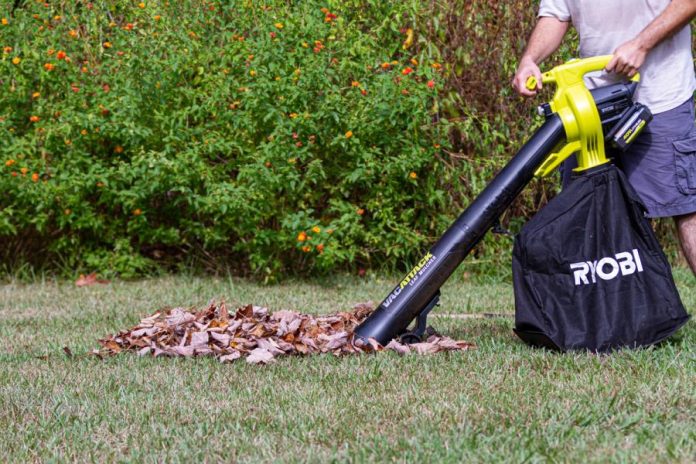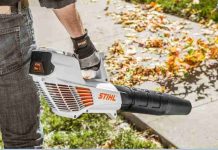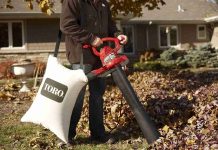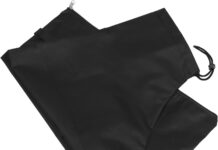Imagine the time and effort saved if we could magically remove all those pesky autumn leaves from our lawns with the wave of a wand. While we might not have a magical solution, leaf vacuums promise a convenient alternative.
But the question that lingers is: do leaf vacuums work? In this article, we will explore the effectiveness of leaf vacuums, uncovering the truth behind their claims and discovering whether they truly live up to their promises.
Different Types of Leaf Vacuums
Handheld Leaf Vacuums
Handheld leaf vacuums are portable devices perfect for cleaning up leaves and other debris in small yards or tight spaces. They are lightweight and easy to maneuver, making them a convenient option for homeowners who prefer a more hands-on approach to leaf removal. Handheld leaf vacuums often contain various attachments to tackle different surfaces and debris.
Backpack Leaf Vacuums
Backpack leaf vacuums are designed for larger yards or areas with more leaves. With the backpack design, the weight of the vacuum is evenly distributed, providing ergonomic comfort during use. These vacuums typically have a higher suction power and collection capacity, allowing for more efficient and extensive leaf removal. They are also an excellent choice for individuals with mobility limitations, as the weight is distributed over the shoulders and back.
Push Leaf Vacuums
Push leaf vacuums are similar to traditional push lawn mowers but with the added functionality of leaf collection. These vacuums feature a wide intake chute at the front that effortlessly picks up leaves and debris as you push it along. This type of leaf vacuum is ideal for medium-sized yards or areas with moderate leaf fall. Push leaf vacuums often have a built-in mulching capability, allowing leaves to be shredded into fine pieces for more straightforward disposal or composting.
Self-Propelled Leaf Vacuums
Self-propelled leaf vacuums offer the convenience of effortless maneuverability. With a propulsion system, these vacuums require minimal effort from the user as they automatically move along and collect leaves. Self-propelled leaf vacuums are perfect for large yards or areas with dense leaf coverage. They typically have potent engines and wide intake chutes to handle substantial quantities of leaves. This type of vacuum is an excellent choice for individuals who want to minimize physical exertion during leaf removal.
How Leaf Vacuums Work
Suction Power
The suction power of a leaf vacuum determines its ability to pick up leaves and debris efficiently. A more substantial suction power allows the vacuum to effectively remove leaves from different surfaces, including grass, pavement, and gravel. The motor’s power directly affects the suction power, so it’s essential to consider this factor when choosing a leaf vacuum.
Mulching Capability
Mulching capability refers to a leaf vacuum’s ability to shred leaves into smaller pieces. This feature is beneficial for several reasons. Firstly, it reduces the overall volume of leaves, allowing for more straightforward disposal and composting. Additionally, shredded leaves can be spread back onto the lawn or garden as a natural fertilizer. A leaf vacuum with a high mulching capability can significantly enhance the efficiency of leaf removal and promote environmental sustainability.
Collection Capacity
A leaf vacuum’s collection capacity determines how much debris it can hold before needing to be emptied. Leaf vacuums with larger collection bags or compartments require fewer stops to empty the unit, making the overall leaf removal process quicker and more convenient. It’s essential to choose a leaf vacuum with a collection capacity that matches the size of your yard and the anticipated volume of leaves.
Power Source
Various sources, including electricity, gasoline, or batteries can power leaf vacuums. Each power source has its advantages and considerations. Electric leaf vacuums are typically more environmentally friendly and require less maintenance, but the cord’s reach limits them. Gasoline-powered leaf vacuums offer more power and mobility but require regular fueling and maintenance. Battery-powered leaf vacuums offer the advantage of cordless operation but may have restrictions on runtime and charging time. Consider your specific needs and preferences when choosing the power source for your leaf vacuum.
Benefits of Using Leaf Vacuums
Time and labor-saving
Using a leaf vacuum can save time and effort compared to traditional methods such as raking or broom. The powerful suction of a leaf vacuum allows you to quickly and efficiently collect leaves in one pass, eliminating the need for repetitive motions and manual labor. With a leaf vacuum, you can complete the task of leaf removal in a fraction of the time it would take using traditional methods.
Efficient Leaf Removal
Leaf vacuums are designed to effectively remove leaves from various surfaces, ensuring a thorough clean-up. Their suction power and specialized attachments enable them to tackle even hard-to-reach areas, such as corners, edges, and crevices. By efficiently collecting leaves, a leaf vacuum prevents them from becoming a breeding ground for pests or blocking drainage systems.
Ease of Use
Leaf vacuums are designed with user-friendliness in mind. They are typically lightweight and easy to maneuver, reducing strain on the user. Many models feature adjustable handles, making it comfortable for individuals of different heights to operate the vacuum. Furthermore, modern leaf vacuums often have intuitive controls and ergonomic features to enhance the user experience.
Multipurpose Functionality
Many leaf vacuums offer additional functionality beyond leaf removal. They may come with attachments or settings that allow them to handle other yard maintenance tasks, such as vacuuming grass clippings or cleaning debris from sidewalks. This multipurpose functionality makes leaf vacuums a versatile tool for maintaining a tidy and clean outdoor space.
Considerations Before Buying a Leaf Vacuum
Yard Size and Terrain
Before purchasing a leaf vacuum, it’s crucial to consider the size of your yard and the type of terrain you have. Different types of leaf vacuums are better suited for specific yard sizes and terrains. Handheld leaf vacuums are ideal for small yards or areas with limited space, while backpack or push leaf vacuums are better for larger yards or areas with rough terrain. Assessing your yard’s characteristics will help you choose the most suitable leaf vacuum.
Leaf Density
If your yard experiences a high density of falling leaves, choosing a leaf vacuum with sufficient suction power is essential to handle the volume effectively. Some leaf vacuums are better equipped to handle dense leaves and debris, ensuring efficient and thorough leaf removal. Consider the leaf density in your yard to select a leaf vacuum that can handle the task without clogging or diminishing performance.
Noise Level
Leaf vacuums can generate varying levels of noise during operation. If noise concerns you or your neighbors, it’s advisable to choose a leaf vacuum with a lower decibel rating. Electric leaf vacuums tend to be quieter compared to gasoline-powered models. Additionally, some manufacturers offer noise-reducing features or technologies in their leaf vacuum designs.
Weight and Portability
Leaf vacuums come in different sizes and weights, and it’s essential to consider the weight and portability when purchasing. Handheld and backpack leaf vacuums are generally lighter and more portable, making them easier to maneuver and store. On the other hand, push and self-propelled leaf vacuums may be bulkier and heavier but provide more power and collection capacity. Consider your physical capabilities and preferences to choose a leaf vacuum you can comfortably handle.
Best Practices for Using Leaf Vacuums
Clear the Area
Before operating a leaf vacuum, take the time to clear the area of any large debris, branches, or stones that could potentially damage the vacuum or cause safety hazards. Clearing the area also ensures optimal performance and prevents clogging.
Adjust Power Settings
Leaf vacuums often have adjustable power settings to accommodate different leaf densities and surface types. Start with a lower power setting and gradually increase it as needed. This will prevent unnecessary damage to delicate surfaces and maximize efficiency.
Utilize Mulching Function
If your leaf vacuum has a mulching function, take advantage of it. Shredding leaves into smaller pieces significantly increases the collection capacity and makes disposal or composting easier. Be sure to follow the manufacturer’s instructions for proper mulching operation.
Empty Collection Bag Regularly
To maintain the leaf vacuum’s optimal performance, regularly empty the collection bag or container as it fills up. A whole bag can reduce suction power and impede airflow, diminishing the vacuum’s effectiveness. Follow the manufacturer’s recommendations for proper disposal of the collected leaves.
Proper Maintenance
Regular maintenance is essential for the longevity and performance of your leaf vacuum. Clean the vacuum after each use, removing any debris or clogs. Also, perform routine maintenance tasks such as oiling the engine, replacing filters, and inspecting the vacuum for any signs of wear or damage. Following the manufacturer’s maintenance instructions will ensure your leaf vacuum remains in optimal condition.
Common Challenges with Leaf Vacuums
Clogging Issues
Leaf vacuums may experience clogging if large debris or wet leaves are sucked into the machine. This can reduce the suction power and require frequent stops for unclogging. To minimize clogging, ensure the area is clear of large debris before vacuuming, and avoid using the leaf vacuum in wet conditions.
Limited Suction Power
Some leaf vacuums, especially handheld models or those designed for smaller yards, may have limited suction power. This can make it challenging to collect leaves and debris effectively, particularly in areas with dense leaf coverage. Consider the suction power of a leaf vacuum before purchasing to ensure it matches your yard’s specific needs.
Battery Life
Battery-powered leaf vacuums offer the advantage of cordless operation, but the battery’s runtime limits them. If you have a large yard or anticipate an extended leaf removal session, battery life becomes critical. Ensure the battery capacity aligns with the size of your yard to prevent interruptions or the need for frequent recharging.
Mulching Effectiveness
While leaf vacuums with mulching capabilities can significantly reduce leaves’ volume, the mulching process’s effectiveness can vary. Some leaf vacuums may produce larger leaf pieces despite claims of effective mulching. Research customer reviews or consult experts to ensure the mulching functionality meets your expectations.
Alternatives to Leaf Vacuums
Leaf Blowers
Leaf blowers are another popular tool for removing leaves from yards. Unlike leaf vacuums, they rely on blowing air to push leaves into piles or out of desired areas. While leaf blowers can be efficient in certain situations, they do not collect the leaves, meaning you would need to manually gather and dispose of the leaves after using the blower.
Rakes and Brooms
Traditional tools such as rakes and brooms have long been used for leaf removal. They are cost-effective options and can provide a workout while removing leaves. However, raking and sweeping leaves can be time-consuming and labor-intensive, especially for larger yards. Additionally, raking can sometimes damage delicate grass or create uneven surfaces.
Outdoor Vacuums
Outdoor vacuums are similar to leaf vacuums but are generally designed for specific outdoor surfaces, such as decks, patios, or pool areas. They may have specialized attachments or features that cater to these surfaces’ unique needs. Outdoor vacuums are a viable alternative if specific areas require regular cleaning and maintenance.
Customer Reviews and Ratings
Positive Reviews
Many customers who have used leaf vacuums express satisfaction with their performance and efficiency. They appreciate the time and labor-saving benefits of using leaf vacuums, particularly in large yards or areas with dense leaf coverage. Positive reviews often mention the ease of use and the ability to collect leaves from various surfaces. Customers also find the mulching capability and additional functionalities to be valuable features.
Negative Reviews
Negative reviews of leaf vacuums often revolve around issues with clogging, particularly when trying to suck up wet leaves or debris. Some customers have also expressed disappointment with limited suction power, mainly in handheld or smaller models. Battery life is another common concern with battery-powered leaf vacuums, as some users find the runtime insufficient for their needs. Mulching effectiveness is also a topic of disappointment in some negative reviews.
Comparative Analysis
When comparing leaf vacuums, it’s advisable to consider both positive and negative reviews to comprehensively understand each model’s strengths and weaknesses. Pay attention to specific concerns that align with your yard’s characteristics and leaf removal needs. Additionally, consider expert recommendations and ratings from reputable sources to make an informed decision.
Cost and Maintenance Comparison
Initial Cost
The initial cost of leaf vacuums can vary significantly depending on the type, brand, and features. Handheld leaf vacuums are generally the most affordable option, ranging from $50 to $150. Backpack leaf vacuums typically range from $150 to $400, while push and self-propelled leaf vacuums can go up to $1000 or higher. Consider your budget and specific requirements when determining the initial cost of investing in a leaf vacuum.
Operating Cost
The operating cost of a leaf vacuum includes factors such as fuel or electricity consumption and the need for replacement parts or accessories. Gasoline-powered leaf vacuums require regular fueling, which adds to the operating cost. Electric leaf vacuums incur electricity costs if used frequently. Battery-powered vacuums may require replacement batteries over time. Assess the potential operating costs associated with each type of leaf vacuum to make an informed decision.
Maintenance and Repairs
Maintenance and repair requirements can vary depending on the type and brand of the leaf vacuum. Handheld and electric leaf vacuums generally have lower maintenance needs compared to gasoline-powered models. Routine maintenance tasks may include cleaning, oiling, and replacing filters. Some manufacturers offer warranties or service packages that cover repairs or maintenance for a certain period. Consider each leaf vacuum’s maintenance requirements and potential costs to ensure you can adequately maintain the device.
Conclusion
Leaf vacuums are practical tools for efficiently removing leaves and debris from your yard. There is a leaf vacuum with various types and features available to suit every yard size and leaf density. Consider factors such as suction power, mulching capability, and power source when selecting a leaf vacuum. The benefits of using a leaf vacuum include time and labor savings, efficient leaf removal, ease of use, and multipurpose functionality.
Before purchasing a leaf vacuum, assess your yard size, terrain, and noise level preferences. Consider the weight and portability of the leaf vacuum to ensure comfortable operation. Remember to follow best practices for using leaf vacuums, including clearing the area before use, adjusting power settings, utilizing the mulching function, emptying the collection bag regularly, and maintaining the vacuum properly.
While leaf vacuums have advantages, be aware of common challenges such as clogging, limited suction power, battery life, and mulching effectiveness. Alternatives to leaf vacuums include leaf blowers, rakes, brooms, and outdoor vacuums. Read customer reviews and ratings to gain insights into the performance and reliability of different leaf vacuum models.
Consider the initial cost, operating cost, and maintenance requirements when comparing and selecting a leaf vacuum. Choosing the right leaf vacuum will allow you to efficiently remove leaves from your yard, saving time and effort while maintaining a clean and tidy outdoor space.



































